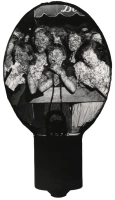
John Vink, Djenné, Mali, January 5, 1986
Water well in front of a mosque.

John Vink, Burkina Faso, March 23, 1985
Women carrying water on a 25-minute walk through rough terrain from the well to their house.

John Vink, T’ln Akoff, Burkina Faso, March 6, 1985
Filling guerbas with water at a pond close to the Malian border.

John Vink, Bia, Mali, December 20, 1985
Schoolchildren watering a vegetable garden. Proceeds from the sale of the vegetables will be used to buy school materials that teach the children to diversify their food habits.

John Vink, Manantali, Mali, January 24, 1986
Building a dam on a tributary of the Senegal stream. Besides providing electricity, the dam will help regulate the level of the river, allowing a more constant flow of water to reach the irrigation project built downstream.
Belgian photojournalist John Vink traveled to Africa in 1985 and spent two years photographing water management issues in Sahel, an area that stretches across the continent from the Atlantic Ocean in the West to the Red Sea in the East. Encompassing parts of Senegal, Mauritania, Mali, Burkina Faso, Niger, Nigeria, Chad, Sudan, and Eritrea, the arid Sahel separates tropical rainforests from Saharan dessert. The lack of fertile soil and rainfall has contributed to numerous droughts and famines in the region; from 1968 to 1974, at least 200,000 people and 5 million livestock died. Access to and preservation of the limited clean water supply continues to be the most crucial issue in Sahel.
Vink was moved by powerful photographs of drought victims from the early 1980s in Mali and Niger. Rather than focusing solely on problems such as erosion and insufficient irrigation, Water in Sahel also highlights solutions. Vink documents how water is transported long distances via jars or goat skins and used to irrigate gardens, how women reduce soil erosion and improve water filtration by stabilizing the terrain. He photographs cooperative farmers working a plot of irrigated land, children watering vegetable gardens, and workers building a dam to produce electricity and regulate water levels. According to the photographer, “This Sub-Saharan part of Africa does not need to be the perpetual victim: there is energy and know-how; local initiatives need relatively little outside help to find adapted solutions to improve the situation.” Since the late 1980s, international aid organizations have contributed money to local officials who are trying to find innovative solutions to minimize the impact of drought, water-borne illnesses, erosion, and desertification. Vink, who was granted a W. Eugene Smith Award in Humanistic Photography for this work in 1986, helped raise the visibility of these issues.

